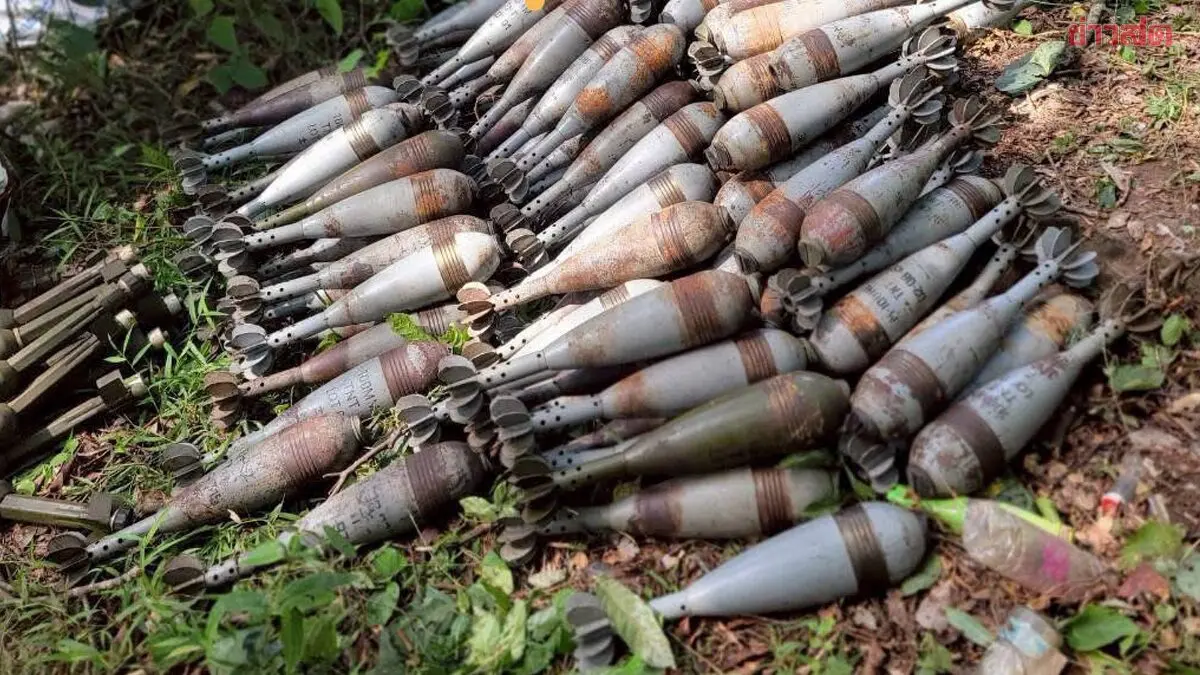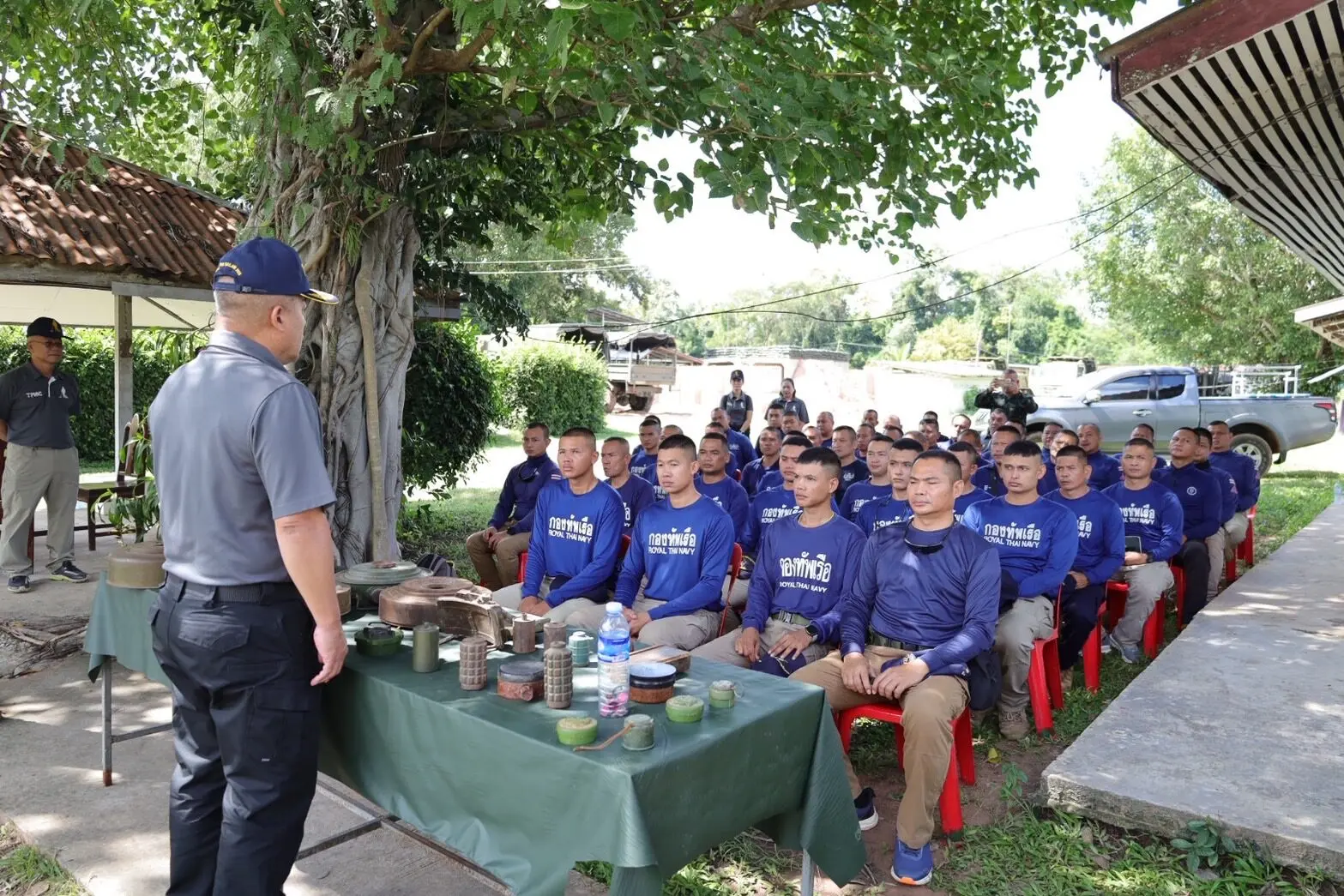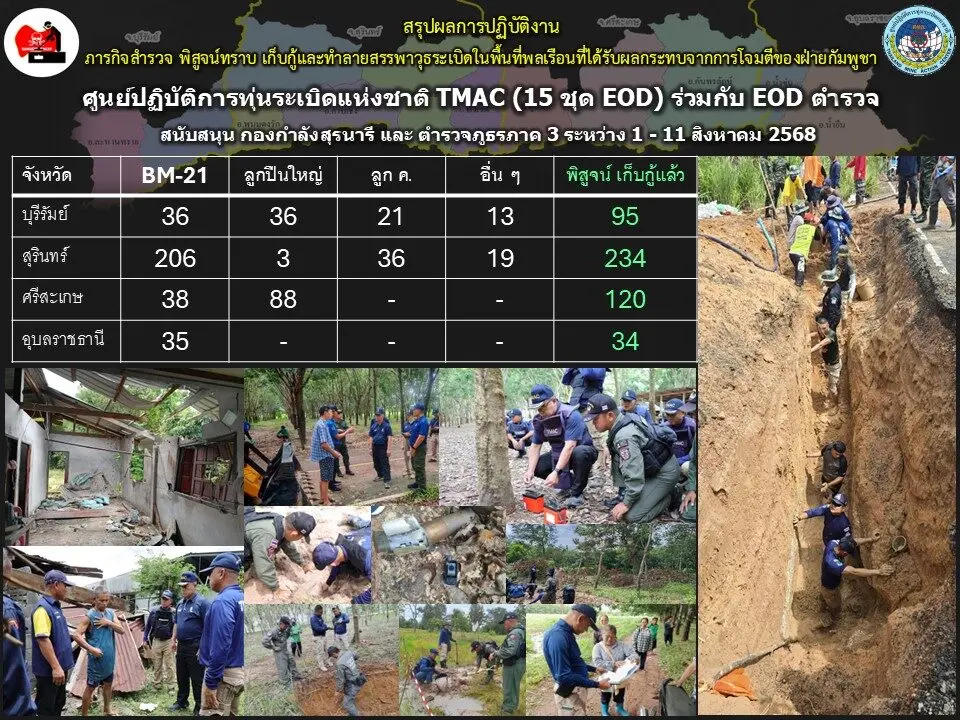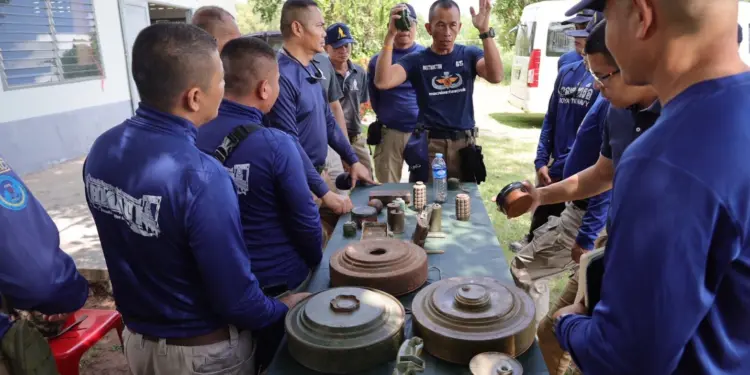Large-scale mine clearance operation inspects four border provinces
Between August 1 and 11, 2025, the National Mine Action Center (TMAC), along with Explosive Ordnance Disposal (EOD) police units, conducted a comprehensive operation to survey, identify, clear, and destroy explosive devices in areas affected by recent Cambodian attacks. The mission supported the Suranaree military command and regional police forces in Northeast Thailand. Fifteen operational teams were deployed across four border provinces, focusing on reducing the threat to local communities. On August 12, General Sakdit Saengchanin, Director of TMAC and commander of military operations, visited the teams at the Suranaree Field Engineering Unit in Prasat district, Surin province, to inspect progress and provide strategic guidance to the personnel. This included nine humanitarian mine clearance teams from TMAC’s divisions 1 through 4.

Detailed results reveal heavy ordnance in Surin and neighboring provinces
During the 11-day operation, the teams successfully cleared a total of 483 explosive devices, covering four provinces along the Thai-Cambodian border. Surin province was the most affected, with 206 BM-21 rocket projectiles, 3 artillery shells, 36 mortar rounds, and 19 other explosive devices, totaling 234 items. In Buriram province, officials found 36 BM-21 rockets, 36 artillery shells, 21 mortar rounds, and 13 other devices, amounting to 95 explosive remnants. Meanwhile, Sisaket province saw 38 BM-21 rockets and 88 artillery shells, making 120 devices in total, and Ubon Ratchathani recorded 35 BM-21 rockets and an additional 34 explosive remnants. The wide variety of ordnance includes heavy rockets, artillery shells, anti-personnel mines, anti-tank mines, and other hazardous explosives such as RPG rounds and grenade launcher ammunition that had failed to detonate during prior conflicts.

Commitment to security, safety, and public awareness
This intensive clearance effort highlights the preparedness and efficiency of Thai security forces in minimizing risks and protecting civilians in vulnerable border regions. Authorities continue to emphasize the importance of educating local residents about the dangers posed by unexploded ordnance and landmines. Citizens in affected areas are urged to report any suspicious or unfamiliar objects immediately to military units, police, or local security agencies to ensure safe disposal. The TMAC teams remain focused on prioritizing the removal of the most dangerous heavy weapons and explosives to pave the way for safe resettlement of displaced populations. This ongoing operation is crucial for restoring peace and safety along the Thai-Cambodian border, safeguarding lives, and preventing further casualties from leftover war remnants.

Large-scale mine clearance operation inspects four border provinces
Between August 1 and 11, 2025, the National Mine Action Center (TMAC), along with Explosive Ordnance Disposal (EOD) police units, conducted a comprehensive operation to survey, identify, clear, and destroy explosive devices in areas affected by recent Cambodian attacks. The mission supported the Suranaree military command and regional police forces in Northeast Thailand. Fifteen operational teams were deployed across four border provinces, focusing on reducing the threat to local communities. On August 12, General Sakdit Saengchanin, Director of TMAC and commander of military operations, visited the teams at the Suranaree Field Engineering Unit in Prasat district, Surin province, to inspect progress and provide strategic guidance to the personnel. This included nine humanitarian mine clearance teams from TMAC’s divisions 1 through 4.

Detailed results reveal heavy ordnance in Surin and neighboring provinces
During the 11-day operation, the teams successfully cleared a total of 483 explosive devices, covering four provinces along the Thai-Cambodian border. Surin province was the most affected, with 206 BM-21 rocket projectiles, 3 artillery shells, 36 mortar rounds, and 19 other explosive devices, totaling 234 items. In Buriram province, officials found 36 BM-21 rockets, 36 artillery shells, 21 mortar rounds, and 13 other devices, amounting to 95 explosive remnants. Meanwhile, Sisaket province saw 38 BM-21 rockets and 88 artillery shells, making 120 devices in total, and Ubon Ratchathani recorded 35 BM-21 rockets and an additional 34 explosive remnants. The wide variety of ordnance includes heavy rockets, artillery shells, anti-personnel mines, anti-tank mines, and other hazardous explosives such as RPG rounds and grenade launcher ammunition that had failed to detonate during prior conflicts.

Commitment to security, safety, and public awareness
This intensive clearance effort highlights the preparedness and efficiency of Thai security forces in minimizing risks and protecting civilians in vulnerable border regions. Authorities continue to emphasize the importance of educating local residents about the dangers posed by unexploded ordnance and landmines. Citizens in affected areas are urged to report any suspicious or unfamiliar objects immediately to military units, police, or local security agencies to ensure safe disposal. The TMAC teams remain focused on prioritizing the removal of the most dangerous heavy weapons and explosives to pave the way for safe resettlement of displaced populations. This ongoing operation is crucial for restoring peace and safety along the Thai-Cambodian border, safeguarding lives, and preventing further casualties from leftover war remnants.





















